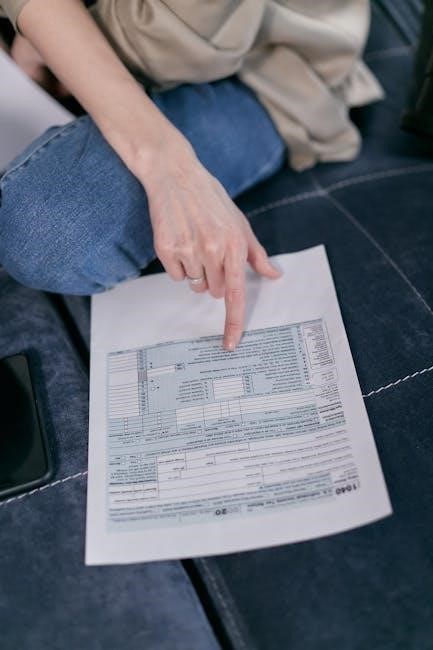Bohemian Rhapsody, a masterpiece by Queen, is a six-minute ballad combining operatic and hard rock elements. Its complex composition and emotional depth make it iconic. Piano sheet music PDFs are widely available for enthusiasts to play this legendary piece.

1.1 Brief History of the Song
Bohemian Rhapsody, written by Freddie Mercury, was released in 1975 on Queen’s album A Night at the Opera. This six-minute ballad combines operatic vocals, a guitar solo, and hard rock elements, making it a groundbreaking track. Initially controversial due to its unconventional structure, it became an instant hit, topping the UK Singles Chart for nine weeks. By 1976, it had sold over one million copies worldwide. Its innovative music video and complex composition set a new standard in music production. The song regained popularity in 1992 after featuring in Wayne’s World, reaching number two in the U.S. charts. It remains one of the best-selling singles of all time, with over 6 million copies sold globally, and was inducted into the Grammy Hall of Fame in 2004.
1.2 Structure and Composition
Bohemian Rhapsody’s structure is unconventional, blending multiple genres into a single track. It begins with a ballad segment, featuring Mercury’s emotive vocals and piano accompaniment. This transitions into an operatic section with layered harmonies, showcasing the band’s vocal range. A hard rock portion follows, characterized by powerful guitar riffs and driving rhythms. The song concludes with a reflective coda. The composition is intricate, with complex key changes and tempo shifts, making it a challenging yet rewarding piece for pianists. The piano sheet music captures this complexity, offering arrangements that range from simplified versions for beginners to detailed transcriptions of the original recording, ensuring accessibility for pianists of all skill levels while preserving the song’s iconic elements.
1.3 Cultural Impact and Popularity

Bohemian Rhapsody has left an indelible mark on music history, becoming a cultural phenomenon. Its innovative blend of genres and theatrical style redefined rock music. The song topped charts globally, including a nine-week run at number one in the UK and resurgence in popularity after Freddie Mercury’s death. It has sold millions worldwide, earning it a place as one of the best-selling singles of all time. The iconic music video, considered groundbreaking, further cemented its status. Its inclusion in the Grammy Hall of Fame and consistent presence in “greatest songs of all time” lists highlight its enduring appeal. The piano sheet music remains highly sought after, reflecting its timeless influence and adaptability for pianists worldwide.

Background of the Song
Bohemian Rhapsody, released in 1975 on A Night at the Opera, was written by Freddie Mercury and produced by Queen and Roy Thomas Baker. This six-minute ballad combines operatic and hard rock elements, becoming a global hit and selling millions worldwide.
2.1 Writing and Composition Process
Freddie Mercury wrote Bohemian Rhapsody in 1975, drawing inspiration from personal experiences and creative experimentation. The song’s structure, blending ballad, operatic, and hard rock sections, was innovative and complex. Mercury composed much of it at his home before presenting it to Queen. The band refined the piece in the studio, with Mercury guiding the operatic vocals and Brian May contributing the iconic guitar solo. The operatic section posed challenges, requiring layered vocal harmonies and precise timing. Produced by Queen and Roy Thomas Baker, the track became a groundbreaking achievement, showcasing the band’s versatility and Mercury’s genius. Its intricate composition and emotional depth have made it a timeless classic.
2.2 Album and Release Details
Bohemian Rhapsody was released on Queen’s fourth studio album, A Night at the Opera, in 1975. The song was also issued as a single, backed by “You’re My Best Friend.” It debuted on BBC Radio 1 and quickly gained attention for its unconventional structure. The single topped the UK Singles Chart for nine weeks and became a global hit, reaching number one in multiple countries. Its success was unprecedented, as it combined operatic vocals, a ballad, and hard rock. The album itself is considered one of Queen’s best works, showcasing their musical versatility. The song’s release marked a turning point in Queen’s career, solidifying their status as pioneers of progressive rock. Its impact remains undeniable, with continued popularity across generations.
2.3 Chart Performance and Reception
Bohemian Rhapsody achieved extraordinary chart success, topping the UK Singles Chart for nine consecutive weeks and becoming a global phenomenon. It reached number one in multiple countries, including Canada, Australia, and New Zealand. The song sold over one million copies worldwide by early 1976 and re-entered the charts in 1992 after featuring in the film Wayne’s World, peaking at number two in the U.S. Its innovative music video and groundbreaking composition earned widespread acclaim. The track became one of the best-selling singles of all time and was inducted into the Grammy Hall of Fame in 2004. Its enduring popularity solidified its status as a rock masterpiece.
Piano Sheet Music Versions

Various arrangements are available, including solo piano, piano with vocals, and full scores. These versions cater to different skill levels, ensuring accessibility for pianists of all abilities.
- Solo piano arrangements capture the song’s essence.
- Piano and vocal versions include lyrics for singers.
- Full score transcriptions offer detailed instrumentation.
3.1 Solo Piano Arrangements
Solo piano arrangements of Bohemian Rhapsody are highly popular, offering a condensed yet powerful version of the song. These arrangements capture the original’s complexity, translating Queen’s iconic composition into a single instrument. Many pianists create their own transcriptions, sharing them online, while professional versions are available on platforms like Musicnotes and MuseScore. These solo arrangements often include the ballad, operatic, and rock sections, maintaining the song’s emotional depth. They are ideal for pianists seeking to master the piece without vocal accompaniment. With varying difficulty levels, solo piano arrangements cater to both intermediate and advanced players, making Bohemian Rhapsody accessible to a wide range of musicians.
3.2 Piano and Vocal Versions
Piano and vocal versions of Bohemian Rhapsody combine the iconic melody with lyrics, perfect for singers and pianists to collaborate. These arrangements often include the ballad and hard rock sections, omitting the operatic parts for simplicity. Many versions are available online, with platforms like Musicnotes and MuseScore offering high-quality sheets. Some arrangements are tailored for vocalists, with the piano accompaniment mirroring the original song’s structure. These versions are ideal for performances or practice, allowing vocalists to shine while the piano provides a dynamic foundation. They maintain the song’s emotional depth and complexity, making them a popular choice for musicians seeking to perform Bohemian Rhapsody in a collaborative setting.
3.3 Full Score Transcriptions
Full score transcriptions of Bohemian Rhapsody capture the song’s intricate layers, including piano, vocals, and orchestral elements. These detailed arrangements are ideal for advanced pianists seeking authenticity. A 24-track score, mirroring the original recording, is available, offering unparalleled accuracy. Such transcriptions often include the operatic section, making them challenging but rewarding. They are perfect for those who want to experience the song’s full complexity. These scores are typically found in specialized sheet music stores or shared by enthusiasts online, such as the Google Drive link provided. Full score transcriptions are a must for musicians aiming to master Queen’s iconic masterpiece in its entirety.
Where to Download the Sheet Music
Download Bohemian Rhapsody piano sheet music from trusted sources like Musicnotes, MuseScore, and Google Drive links shared by enthusiasts. Free and paid options are available for all skill levels.
4.1 Free Resources and Websites
Several websites offer free Bohemian Rhapsody piano sheet music in PDF format. Platforms like MuseScore and Musicnotes provide free versions, though some may be simplified. Google Drive links shared by enthusiasts, such as this one, offer detailed arrangements. Additionally, websites like ACG Education Music and Sheetmusic-free.com host free PDFs. These resources cater to pianists of all levels, ensuring accessibility for those who want to play this iconic piece without cost. While free versions may omit complex sections like the operatic part, they still capture the song’s essence, making them a great starting point for enthusiasts.
4.2 Paid Options for High-Quality Sheets
For those seeking high-quality, accurate arrangements, paid options offer superior detail and precision. Websites like Musicnotes provide premium Bohemian Rhapsody sheet music, including versions by renowned arrangers like Peter Bence and Costantino Carrara. These sheets often include intricate piano transcriptions that closely match the original recording. Additionally, platforms like MuseScore offer paid versions with full scores and instrumental parts, ideal for detailed study. While free versions are available, paid options ensure professionalism and accuracy, making them worth the investment for serious pianists. These sheets are perfect for musicians aiming to master the song’s complex structure and emotional depth.
4.3 User-Shared Links and Communities
Online communities and forums often share user-generated links for Bohemian Rhapsody sheet music. Platforms like Google Drive and MuseScore host user-uploaded arrangements, ranging from solo piano transcriptions to full scores. These shared resources are often created by enthusiasts and musicians, offering unique interpretations. Communities on websites like Pianoshelf and Reddit provide spaces for users to exchange and download sheet music. Additionally, some creators share their arrangements on personal blogs or social media, making it easier for pianists to access diverse versions. These user-shared links and collaborative platforms foster a sense of community and provide accessible options for those seeking specific arrangements of the song.
Features of the Sheet Music
The sheet music for Bohemian Rhapsody includes intricate piano arrangements, operatic sections, and detailed vocal lines. It spans 10 pages, offering versions for solo piano, piano-vocal, and full scores.
5.1 Different Arrangements Available
Bohemian Rhapsody piano sheet music is available in various arrangements to suit different skill levels and preferences. Solo piano versions offer a stripped-down yet powerful interpretation, while piano-vocal arrangements include lyrics for singers. Full scores provide intricate details, capturing the song’s complexity. Some versions omit the operatic section for simplicity, making them more accessible. Additionally, there are arrangements that combine piano with other instruments, offering a richer sound. For beginners, simplified sheets focus on the melody and basic harmonies, while advanced players can explore exact transcriptions of the original recording. These diverse arrangements ensure that pianists of all levels can enjoy playing this iconic piece.

5.2 Difficulty Levels for All Pianists
Bohemian Rhapsody piano sheet music is available in various difficulty levels, catering to pianists of all skill levels. Beginners can start with simplified versions that focus on the melody and basic harmonies, while intermediate players can explore arrangements that introduce more complex techniques. Advanced pianists will appreciate the intricate details and challenging passages found in exact transcriptions of the original recording. Some sheets also offer a gradual learning curve, allowing pianists to build skill as they progress. This versatility ensures that everyone, from novices to seasoned musicians, can enjoy playing this iconic piece while challenging themselves appropriately.
How to Play Bohemian Rhapsody on Piano
Start with simplified versions, practice sections slowly, and gradually build speed. Focus on hand coordination and emotional expression to master this iconic piece effectively.
6.1 Tips for Beginner Pianists
Beginners should start with simplified arrangements of Bohemian Rhapsody to build confidence. Practice each section slowly, focusing on hand coordination and rhythm. Use a metronome to maintain tempo consistency. Break the song into smaller parts, mastering one section at a time. Pay attention to dynamics and emotional expression to capture the song’s essence. Simplify complex passages initially, then gradually incorporate more details as skill improves. Utilize online tutorials and video guides for visual guidance. Most importantly, stay patient and enjoy the journey of learning this iconic piece.
6.2 Overcoming Common Challenges
Mastering Bohemian Rhapsody on piano can be daunting due to its complex structure and fast arpeggios. Beginners often struggle with the operatic section, which requires precise timing and hand coordination. To overcome this, practice each part slowly, focusing on accuracy. Use a metronome to maintain rhythm and break the song into manageable sections. Simplify challenging passages initially, then gradually incorporate more complexity. Emphasize dynamics and emotional expression to capture the song’s essence. Additionally, watch video tutorials for visual guidance and consider using practice software to slow down difficult sections. With patience and consistent practice, even the most intricate parts become achievable.

Resources and Tutorials
Find Bohemian Rhapsody piano tutorials on YouTube and sheet music downloads from Musicnotes and Musescore. These resources offer step-by-step guides and accurate transcriptions for all skill levels.
7.1 Recommended Websites for Sheet Music
For high-quality Bohemian Rhapsody piano sheet music, visit Musicnotes and Musescore. These platforms offer accurate transcriptions, including solo piano and vocal arrangements. BossPianoSheets provides free and premium sheets, while Pianoshelf hosts community-shared scores. For exact transcriptions, check the Google Drive link or the WordPress PDF. These sites cater to all skill levels, ensuring you find the perfect arrangement to play this iconic song.
7.2 Video Tutorials and Guides
Mastering Bohemian Rhapsody on piano is easier with video tutorials. YouTube channels like Peter Bence and Costantino Carrara offer detailed guides. For beginners, easy piano tutorials break down complex sections. Advanced players can explore performance recordings for inspiration. Additionally, video guides and step-by-step lessons provide comprehensive instruction. These resources help pianists of all levels conquer the song’s iconic sections, from the ballad to the operatic parts.

Song Structure and Sections
Bohemian Rhapsody features a ballad, operatic section, and hard rock finale, with no traditional chorus. Its intricate structure includes a guitar solo, making it one of music’s most elaborate recordings.
8.1 Ballad Segment and Melody
The ballad segment of Bohemian Rhapsody opens with a hauntingly beautiful melody, showcasing Freddie Mercury’s emotional vocals. The piano accompaniment is simple yet powerful, providing a delicate foundation for the song’s dramatic build-up. This section transitions seamlessly into the operatic part, maintaining the song’s theatrical essence. The melody’s structure, with its soaring highs and introspective lows, has been meticulously transcribed into piano sheet music, allowing pianists to capture the song’s emotional depth. The ballad’s guitar solo further enhances its complexity, making it a standout piece in rock music history. The sheet music for this segment is widely available, offering pianists a chance to recreate its magic.
8.2 Operatic Section Techniques
The operatic section of Bohemian Rhapsody is a technically demanding part of the song, featuring complex vocal layering and dramatic intensity. The piano sheet music captures this grandeur by incorporating arpeggios and intricate chord progressions that mimic the operatic vocals. Pianists must master dynamic shifts and tempo changes to maintain the section’s theatrical feel. The sheet music often includes detailed fingerings and pedaling instructions to enhance the dramatic effect. This section is a highlight for advanced pianists, showcasing their ability to convey the song’s emotional depth and complexity. The operatic part remains one of the most challenging yet rewarding sections to perform.

Historical Significance
Bohemian Rhapsody is a groundbreaking song released in 1975, known for its innovative production and blending of genres. It remains one of the most iconic and influential tracks in music history.
9.1 Impact on Music History
Bohemian Rhapsody revolutionized music production with its innovative structure and genre-blending style. Released in 1975, it became a cultural phenomenon, topping charts globally and inspiring countless artists. The song’s six-minute format, combining ballad, operatic, and hard rock elements, defied traditional radio standards. Its groundbreaking video and elaborate recording techniques set new benchmarks in the industry. Inducted into the Grammy Hall of Fame in 2004, it remains one of the best-selling singles of all time, with over a million copies sold in 1976 alone. Its influence is evident in modern music, solidifying its legacy as a landmark in rock history.
9.2 Sales and Chart Legacy
Bohemian Rhapsody achieved unparalleled commercial success, topping charts worldwide. It peaked at number one in the UK for nine weeks and again in 1991 after Freddie Mercury’s death. In the U.S., it reached number two in 1992 following its feature in Wayne’s World. The song has sold over six million copies in the UK alone and is certified 4x Platinum. Globally, it remains one of the best-selling singles of all time, with sales exceeding 10 million copies. Its enduring popularity is evident in its consistent chart reappearances and over a billion streams on platforms like YouTube. This legacy solidifies its status as a timeless classic in music history.

Best Arrangements Available
The most accurate Bohemian Rhapsody arrangements include a full 24-track score and exact piano transcriptions. Notable versions by Jarrod Radnitch and Peter Bence offer precise details for pianists. These sheets capture the song’s complexity, ensuring authenticity for both beginners and advanced players.
10.1 Most Accurate Transcriptions
The most accurate Bohemian Rhapsody transcriptions include a full 24-track score, offering precise details from the original recording. These transcriptions capture every nuance, from the ballad to the operatic sections. A highly recommended version is the full score transcription, which mirrors the studio recording. Additionally, the EMI/Warner-published book contains an extremely accurate transcription, considered one of the best available. These sheets are ideal for professionals and enthusiasts seeking authenticity. They can be found on platforms like Google Drive and Musicnotes.
10.2 Easy Versions for Beginners
For those new to playing Bohemian Rhapsody, simplified piano arrangements are available. These versions omit complex sections, like the operatic part, making the song more accessible. Platforms like Musicnotes and Patreon offer easy-to-play sheets. These arrangements focus on the ballad and hard rock segments, maintaining the song’s essence while reducing difficulty. Beginners can also find free PDFs on sites like A Gede Music. These resources are perfect for practicing and enjoying the song without overwhelming technical challenges.






























